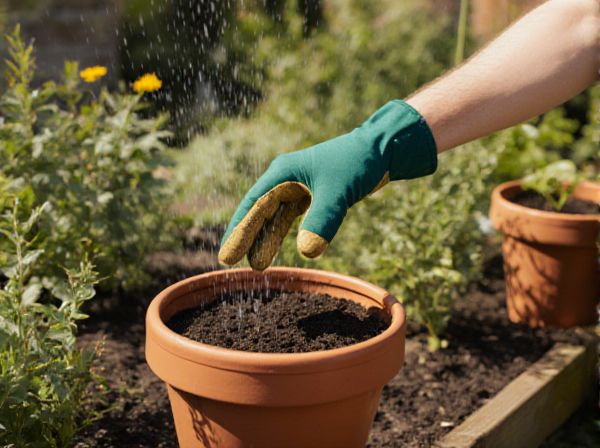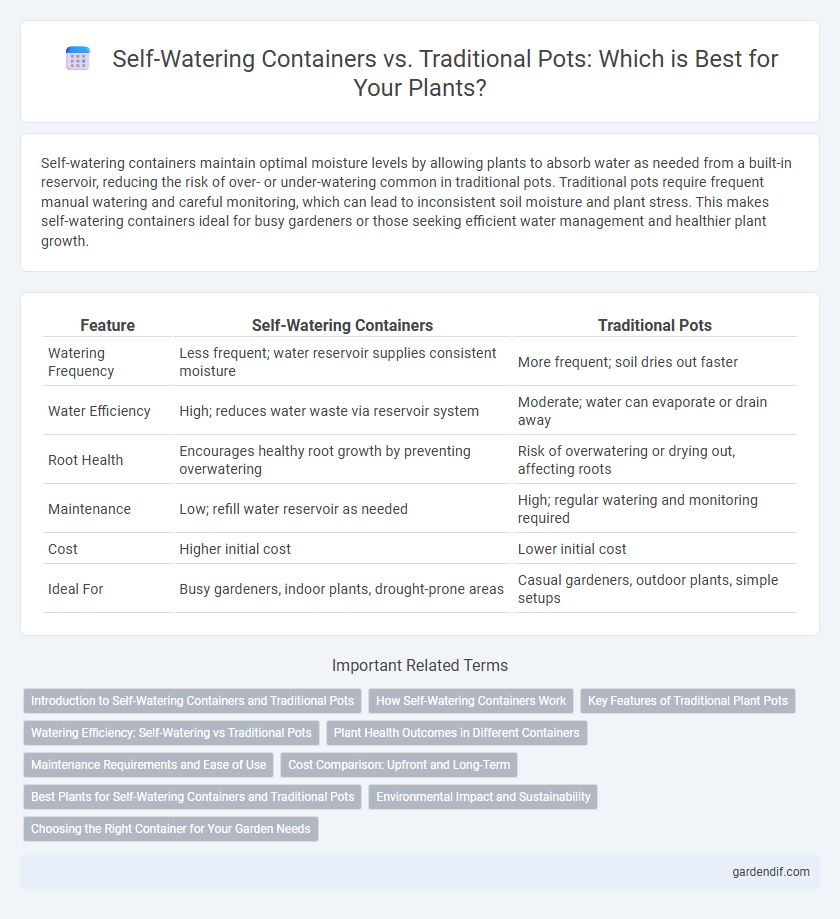
Self-watering containers vs Traditional pots Illustration
Self-watering containers maintain optimal moisture levels by allowing plants to absorb water as needed from a built-in reservoir, reducing the risk of over- or under-watering common in traditional pots. Traditional pots require frequent manual watering and careful monitoring, which can lead to inconsistent soil moisture and plant stress. This makes self-watering containers ideal for busy gardeners or those seeking efficient water management and healthier plant growth.
Table of Comparison
| Feature | Self-Watering Containers | Traditional Pots |
|---|---|---|
| Watering Frequency | Less frequent; water reservoir supplies consistent moisture | More frequent; soil dries out faster |
| Water Efficiency | High; reduces water waste via reservoir system | Moderate; water can evaporate or drain away |
| Root Health | Encourages healthy root growth by preventing overwatering | Risk of overwatering or drying out, affecting roots |
| Maintenance | Low; refill water reservoir as needed | High; regular watering and monitoring required |
| Cost | Higher initial cost | Lower initial cost |
| Ideal For | Busy gardeners, indoor plants, drought-prone areas | Casual gardeners, outdoor plants, simple setups |
Introduction to Self-Watering Containers and Traditional Pots
Self-watering containers feature a built-in reservoir that supplies water directly to plant roots, enhancing moisture retention and reducing the frequency of watering compared to traditional pots. Traditional pots rely on surface watering, which can lead to uneven moisture distribution and increased risk of over- or under-watering. The design of self-watering containers fosters healthier root systems and promotes efficient water usage, making them ideal for busy gardeners and water-conscious environments.
How Self-Watering Containers Work
Self-watering containers utilize a built-in reservoir that delivers water directly to plant roots through capillary action, reducing the risk of overwatering and underwatering. This system maintains consistent soil moisture by allowing the plant to absorb water as needed, enhancing root health and promoting faster growth compared to traditional pots. Traditional pots rely on surface watering, which can cause uneven moisture distribution and frequent watering schedules.
Key Features of Traditional Plant Pots
Traditional plant pots are typically made from materials like clay, ceramic, or plastic, which provide varying levels of breathability and moisture retention. They rely on manual watering, drainage holes for excess water to escape, and require regular monitoring to prevent root rot or dehydration. These pots offer versatility in plant placement but demand consistent care to maintain optimal soil moisture and plant health.
Watering Efficiency: Self-Watering vs Traditional Pots
Self-watering containers significantly improve watering efficiency by providing a consistent moisture level directly to plant roots through a built-in reservoir, reducing water waste and the risk of over- or under-watering. Traditional pots require frequent manual watering, which often leads to uneven soil moisture and increased evaporation losses. Studies show self-watering containers can reduce water usage by up to 30% compared to traditional pots, making them ideal for conserving water while promoting healthier plant growth.
Plant Health Outcomes in Different Containers
Self-watering containers promote consistent moisture levels, reducing root stress and improving overall plant health compared to traditional pots that require frequent manual watering. These containers help prevent overwatering and underwatering, minimizing root rot and nutrient deficiencies. Plants grown in self-watering systems typically exhibit stronger root development, higher yield, and increased resistance to pests and diseases.
Maintenance Requirements and Ease of Use
Self-watering containers significantly reduce maintenance requirements by providing a consistent water supply through a built-in reservoir, minimizing the frequency of watering compared to traditional pots. These containers help prevent overwatering and underwatering, making them ideal for busy gardeners or those new to plant care. Traditional pots require more frequent monitoring and manual watering, increasing the time and effort needed to maintain healthy plants.
Cost Comparison: Upfront and Long-Term
Self-watering containers typically have a higher upfront cost than traditional pots due to integrated reservoirs and wicking systems, but they reduce the need for frequent watering and plant replacements, leading to long-term savings on water and maintenance. Traditional pots are less expensive initially but may incur higher costs over time from increased water use and plant stress-related losses. Evaluating total expenses over the lifespan of the container reveals that self-watering systems offer better economic efficiency, especially in water-scarce regions or for busy gardeners.
Best Plants for Self-Watering Containers and Traditional Pots
Self-watering containers are ideal for moisture-loving plants like ferns, peace lilies, and herbs such as basil and mint, as they provide consistent hydration preventing root rot and wilting. Traditional pots work well for succulents, cacti, and drought-tolerant perennials like lavender and rosemary, which require well-drained soil and less frequent watering. Choosing the right container depends on your plant's water needs and root system, with self-watering containers supporting plants prone to drying out, while traditional pots suit species adapted to drier conditions.
Environmental Impact and Sustainability
Self-watering containers significantly reduce water waste by delivering moisture directly to plant roots, promoting efficient water usage and lowering the overall environmental footprint compared to traditional pots. Traditional pots often require frequent watering, leading to higher water consumption and increased runoff, which can contribute to soil erosion and nutrient loss. Using self-watering containers supports sustainable gardening practices by conserving water resources and minimizing the need for chemical fertilizers through improved moisture retention.
Choosing the Right Container for Your Garden Needs
Self-watering containers offer consistent moisture control by utilizing a reservoir system that reduces water stress and promotes healthier root development compared to traditional pots, which rely on surface watering and can lead to uneven soil moisture. These containers enhance water efficiency, making them ideal for gardeners in drought-prone regions or those seeking low-maintenance options. Selecting the right container depends on factors such as plant species, watering habits, and environmental conditions to optimize growth and resource use.
Self-watering containers vs Traditional pots Infographic

 gardendif.com
gardendif.com